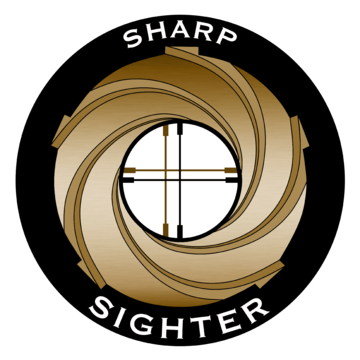Frequently Asked Questions
Sharp Sighter™ was designed, assembled, and substantially manufactured in the United States of America.
Yes, most barrels are machine-turned to be concentric to the bore once the bore is machined.This is required for balance and good harmonics.Our experience is that this is within 5 MOA of the shooting boresight for most rifles and precision rifles this is less than 2 MOA typically. Furthermore, any offset that does exist is constant and extremely repeatable.
No, since we mount to the barrel outer diameter, our one model will work with all calibersif thebarrel diameter is less than 1.45”.
Finger-tight, snug, is adequate.The flexible nylon clam bars help prevent accidental overtightening. You can experiment with repeatability and tightening technique by seeing how repeatable the measurements are when you mount and remount the Sharp Sighter™ system multiple times in succession.
The material used for the barrel vee mount is hard aluminum but is softer than your barrel. If you diligently wipe any grit from the barrel surface and the vee surface, prior to mounting, there will be no scratching or cosmetic damage. Also, don’t overtighten and rotate or slide the vee mount on the barrel excessively.
Yes. Instructions are provided on how to deal with barrel taper.
You may check this by mounting the reflector at various locations near the muzzle. If the indicated alignment seems to vary then the reflector may be mounted on a precision compensator. In this case we recommend replacing the standard crushed washer with a precision spacer washer for greater accuracy in alignment to the muzzle and rifle bore.
The optics and mechanics in the Sharp Sighter™ design are stable to uniform environmental temperature changes. However, temperature may affect your riflescope and rifle barrel. You can determine this yourself with experiments.
Yes, if you want to characterize the stiffness of an assembly, the angular stiffness can be characterized by adding a known weight to the reference mirror assembly and measuring the angular change. This change measures the assembled stiffness = force/deflection of the barrel with respect to the scope bridge on the breach. This measurement can reveal defective assembly issues such as poor fitment and improperly torqued fasteners.
Yes, the tool is that sensitive, and can help guide you to adjust your aimpoint if necessary.
Don’t, unless absolutely necessary. If in doubt leave it dirty since the performance is unchanged by dust and small smears. The optics are precision optics and should never be touched with your greasy fingers. If contact does occur the illuminator cube can be air dusted and then cleaned carefully with a microfiber cloth with a huff of breath or a good lens cleaning agent. The mirror is a precision first surface coating that can be damaged by harsh wiping.If it becomes necessary to clean the mirror, then remove the aluminum cover and run the mirror under tap water to remove grit and dust. Then use a good lens cleaning agent to rinse off grime, followed a good water rinse and then blow dry with an optical air duster. Any remaining streaks may be gently removed with a microfiber cloth and a good optics cleaning solution.
No, some choose to shoot with iron sights.
No, some prefer to be surprised when they take their first shot after transporting their firearm.
No, who really needs to learn about all the sensitivities of their firearm to handling and position.
No, just like no one really needs a caliper or micrometer. However, those that do, know the value!
